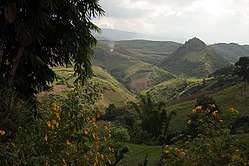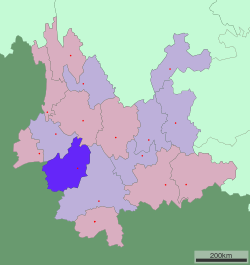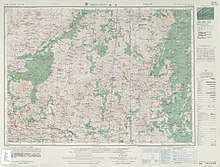Lincang
Lincang (simplified Chinese: 临沧; traditional Chinese: 臨滄; pinyin: Líncāng) is a prefecture-level city located in the southwest of Yunnan province, People's Republic of China.
Lincang 临沧市 | |
|---|---|
 View of a cultivated area from a road in Lincang | |
 Location of Lincang City jurisdiction in Yunnan | |
 Lincang Location in China | |
| Coordinates (Lincang municipal government): 23°53′02″N 100°05′20″E | |
| Country | People's Republic of China |
| Province | Yunnan |
| Admin HQ | Linxiang |
| Area | |
| • Total | 23,620.72 km2 (9,120.01 sq mi) |
| Elevation | 1,517 m (4,977 ft) |
| Population (2010) | |
| • Total | 2,429,505 |
| • Density | 100/km2 (270/sq mi) |
| Time zone | UTC+8 (China Standard) |
| Postal code | 677XXX |
| Area code(s) | 0883 |
| ISO 3166 code | CN-YN-09 |
| Licence plate prefixes | 云S |
| Website | www |
Geography and climate

Lincang covers latitude 23° 05′-25° 02′ N and longitude 98° 40′-100° 33′ E, thus straddling the Tropic of Cancer in the southern part of its administrative area, or prefecture. It is situated on the middle to lower reaches of the Mekong, known as the Lancang in China, and the Salween, or the Nu. Bordering prefectures are Pu'er to the southeast, and Baoshan and Dali to the northwest. It also borders Burma's Shan State. Elevations within the prefecture range from 450 to 3,504 metres (1,476 to 11,496 ft).
Located at an altitude of above 1,450 m (4,760 ft) and within 30 arc minutes to the north of the Tropic of Cancer, Lincang has a mild subtropical highland climate (Köppen Cwb), bordering on a humid subtropical climate (Köppen Cwa), with muddled distinction between the seasons and daytime temperatures remaining warm year-round. Highs peak in May before the core of the rainy season and reach a minimum in December; however, the warmest and coolest months are June and January respectively. June through September accounts for nearly 70% of the annual rainfall of 1,149 mm (45.2 in) and during this time, some rainfall occurs on most days, pushing relative humidity above 80% and there is a marked reduction in sunshine. With monthly percent possible sunshine ranging from 22% in July to 73% in January, the city receives 2,105 hours of bright sunshine annually.
| Climate data for Lincang (1981−2010 normals) | |||||||||||||
|---|---|---|---|---|---|---|---|---|---|---|---|---|---|
| Month | Jan | Feb | Mar | Apr | May | Jun | Jul | Aug | Sep | Oct | Nov | Dec | Year |
| Record high °C (°F) | 25.9 (78.6) |
28.6 (83.5) |
30.5 (86.9) |
32.4 (90.3) |
34.2 (93.6) |
34.4 (93.9) |
31.6 (88.9) |
31.7 (89.1) |
30.9 (87.6) |
29.6 (85.3) |
27.2 (81.0) |
25.8 (78.4) |
34.4 (93.9) |
| Average high °C (°F) | 20.4 (68.7) |
22.1 (71.8) |
25.0 (77.0) |
26.9 (80.4) |
27.1 (80.8) |
26.6 (79.9) |
26.0 (78.8) |
26.6 (79.9) |
25.9 (78.6) |
24.4 (75.9) |
21.9 (71.4) |
19.8 (67.6) |
24.4 (75.9) |
| Daily mean °C (°F) | 11.7 (53.1) |
13.7 (56.7) |
16.9 (62.4) |
19.3 (66.7) |
21.0 (69.8) |
21.9 (71.4) |
21.7 (71.1) |
21.7 (71.1) |
20.7 (69.3) |
18.8 (65.8) |
14.9 (58.8) |
11.8 (53.2) |
17.8 (64.1) |
| Average low °C (°F) | 5.3 (41.5) |
7.2 (45.0) |
10.3 (50.5) |
13.3 (55.9) |
16.4 (61.5) |
19.0 (66.2) |
19.2 (66.6) |
18.8 (65.8) |
17.6 (63.7) |
15.3 (59.5) |
10.3 (50.5) |
6.3 (43.3) |
13.3 (55.8) |
| Record low °C (°F) | 0.5 (32.9) |
1.5 (34.7) |
0.9 (33.6) |
8.4 (47.1) |
10.2 (50.4) |
13.4 (56.1) |
14.6 (58.3) |
14.8 (58.6) |
10.9 (51.6) |
7.9 (46.2) |
3.3 (37.9) |
−1.0 (30.2) |
−1.0 (30.2) |
| Average precipitation mm (inches) | 9.7 (0.38) |
18.3 (0.72) |
18.6 (0.73) |
37.6 (1.48) |
107.0 (4.21) |
177.6 (6.99) |
238.2 (9.38) |
217.8 (8.57) |
154.0 (6.06) |
106.9 (4.21) |
51.0 (2.01) |
12.2 (0.48) |
1,148.9 (45.22) |
| Average precipitation days (≥ 0.1 mm) | 3.3 | 4.9 | 6.2 | 11.4 | 16.1 | 23.4 | 26.5 | 24.0 | 21.1 | 15.3 | 9.2 | 3.2 | 164.6 |
| Average relative humidity (%) | 63 | 57 | 53 | 57 | 68 | 79 | 83 | 81 | 80 | 78 | 74 | 70 | 70 |
| Mean monthly sunshine hours | 245.4 | 224.6 | 236.4 | 211.0 | 185.3 | 109.1 | 91.7 | 121.7 | 124.9 | 150.9 | 177.9 | 226.5 | 2,105.4 |
| Percent possible sunshine | 73 | 70 | 64 | 56 | 45 | 27 | 22 | 30 | 34 | 42 | 54 | 69 | 48 |
| Source: China Meteorological Administration (precipitation days and sunshine 1971–2000)[1][2] | |||||||||||||
Subdivisions
| Map | |||||
|---|---|---|---|---|---|
| Name | Hanzi | Hanyu Pinyin | Population (2010) |
Area (km²) | Density (/km²) |
| Linxiang District | 临翔区 | Línxiáng Qū | 323,708 | 2,652 | 122 |
| Fengqing County | 凤庆县 | Fèngqìng Xiàn | 458,330 | 3,451 | 133 |
| Yun County | 云县 | Yún Xiàn | 449,460 | 3,760 | 120 |
| Yongde County | 永德县 | Yǒngdé Xiàn | 369,702 | 3,296 | 112 |
| Zhenkang County | 镇康县 | Zhènkāng Xiàn | 176,356 | 2,642 | 67 |
| Shuangjiang Lahu, Va, Blang and Dai Autonomous County | 双江拉祜族佤族布朗族傣族自治县 | Shuāngjiāng Lāhùzú Wǎzú Bùlǎngzú Dǎizú Zìzhìxiàn | 176,549 | 2,292 | 77 |
| Gengma Dai and Va Autonomous County | 耿马傣族佤族自治县 | Gěngmǎ Dǎizú Wǎzú Zìzhìxiàn | 296,302 | 3,837 | 77 |
| Cangyuan Va Autonomous County | 沧源佤族自治县 | Cāngyuán Wǎzú Zìzhìxiàn | 179,098 | 2,539 | 71 |
Demography
Lincang is the mountainous home of the Wa ethnic minority and was historically seen as too "wild" to be worth settling by neighboring powers, notably British Burma and ancient China. This may have had some connection to the Wa's image as head-hunters.
Natural resources
Mineral resources mined and extracted in the Lincang area include coal (including waste coal ash), germanium and uranium.[3] Lincang is also home to the world's oldest cultivated tea tree, some 3,200 years old, in the village of Jinxiu (锦绣), Xiaowan town, of Fengqing County.[4][5]
Transport
References
- 中国气象数据网 - WeatherBk Data (in Chinese). China Meteorological Administration. Retrieved 2020-04-15.
- 中国地面国际交换站气候标准值月值数据集(1971-2000年). China Meteorological Administration. Archived from the original on 2013-09-21. Retrieved 2010-05-25.
- Sparton Resources Inc.
- The Oldest Tea Tree on the Earth, (Kunming, 2006).
- News article about oldest tea tree
